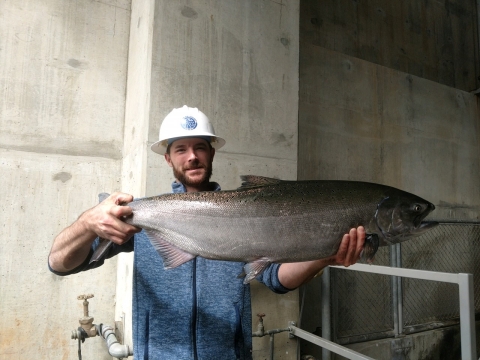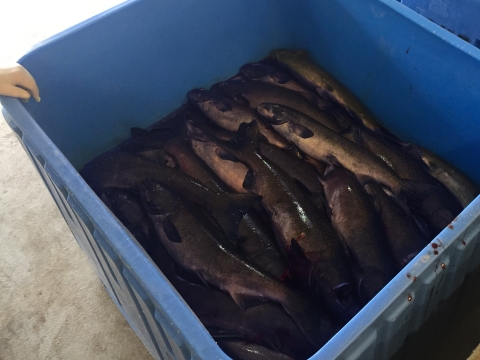What We Do
Part of the U.S. Fish and Wildlife Service mission is to work with partners to achieve aquatic conservation goals. We also meet tribal trust obligations.
Management and Conservation
Part of the U.S. Fish and Wildlife Service mission is to work with partners. At Winthrop National Fish Hatchery, one important partner is Douglas County Public Utility District’s Methow Fish Hatchery. Together, we raise spring Chinook salmon to provide fish for tribal, commercial and sport fisheries and to boost the wild population. We do this through a "stepping stone" conservation model, which has been in action since 2010.
Each year, the Methow hatchery collects wild adult spring Chinook and spawns them in its facility. The progeny of these wild fish are raised at the Methow hatchery, where they are internally tagged. When these tagged fish return as adults to spawn, our Winthrop hatchery collects them for their broodstock broodstock
The reproductively mature adults in a population that breed (or spawn) and produce more individuals (offspring or progeny).
Learn more about broodstock . Because they are tagged, they are distinguishable from wild spring Chinook by using a tag reader, which allows the hatcheries to keep their broodstock populations separate. The fish reared at our Winthrop hatchery are therefore the progeny of the spring Chinook raised at the Methow hatchery. This describes the stepping stone model, where the Methow hatchery raises Chinook derived from the wild population, and our Winthrop hatchery raises Chinook taken from the the Methow hatchery population.
Winthrop National Fish Hatchery spring Chinook receive both an internal tag and external adipose fin clip. Removal of this fin signals anglers that the fish can be kept (in lower Columbia sport and commercial fisheries) and helps identify Winthrop hatchery from Methow hatchery Chinook.
Winthrop hatchery spring Chinook are rarely used in spawning operations, which means that spring Chinook are only raised up to two generations in the hatchery environment. This reduces the effects of domestication, one of the benefits of a stepping stone model. Many hatchery fish have been born in and released from hatcheries for generations. The fish that thrive best in tanks are often the ones most likely to survive to spawn later, biasing the population towards traits that might not serve salmon well in wild conditions.
The stepping stone model has also allowed for the development of more tribal partnerships. Because Winthrop hatchery spring Chinook are not used in spawning operations, but still return to the hatchery as adults to spawn, there is an excess of salmon. This affords us the opportunity to offer a tribal food program, where fresh spring Chinook are given to local tribes weekly throughout May, June, and even July. Excessing hatchery salmon to the tribes also leaves more room in the rivers for wild (or near wild) fish to spawn naturally.
Our Services
You'll find useful data in this section.
Spring Chinook return up the fish ladder to the adult holding facility at the hatchery. But the ladder is not opened for coho or steelhead. Coho for broodstock broodstock
The reproductively mature adults in a population that breed (or spawn) and produce more individuals (offspring or progeny).
Learn more about broodstock are collected at Wells Dam; and steelhead for broodstock are collected in the river. The numbers presented here represent those collected for broodstock. Salmon and steelhead returns:
- 2021: 265 steelhead collected for Winthrop NFH.
- 2021: 1,028 spring Chinook returned to Winthrop NFH.
- 2021: 785 coho collected for Winthrop NFH.
- 2020: 212 steelhead collected for Winthrop NFH.
- 2020: 974 spring Chinook returned to Winthrop NFH.
- 2020: 842 coho collected for Winthrop NFH.
- 2019: 275 steelhead collected for Winthrop NFH.
- 2019: 1,249 spring Chinook returned to Winthrop NFH.
- 2019: 1,386 coho collected for Winthrop NFH.
- 2018: 333 steelhead collected for Winthrop NFH.
- 2018: 1,377 spring Chinook returned to Winthrop NFH.
- 2018: 1,285 coho collected for Winthrop NFH.
- 2017: 1,577 spring Chinook returned to Winthrop NFH.
- 2017: 1,251 coho collected for Winthrop NFH.
Track our salmon as they return via the Fish Passage Center's website.
Weather data is collected daily at the hatchery. Data are displayed on the National Oceanic and Atmospheric Administration's website here.
Our Projects and Research
There's more to our hatchery than meets the eye! We aim to restore and support native fish populations. Read about our projects with coho, steelhead, and spring Chinook.
Laws and Regulations
We provide fish to tribes as part of meeting federal tribal trust responsibilities.



